Pressure Ulcer Prevention: Evaluating Risk Assessment Scales
VerifiedAdded on 2020/05/11
|29
|9113
|45
Report
AI Summary
This report provides a comprehensive analysis of pressure ulcer prevention, focusing on the comparison between the Braden and Waterlow scales for risk assessment in healthcare settings. The introduction highlights the prevalence and impact of pressure ulcers, particularly among the geriatric population, emphasizing the need for effective prevention strategies. The report outlines a systematic search strategy, detailing the databases used (CINAHL, Google Scholar, Cochrane, and Medline), keywords, and selection criteria for relevant literature. It then critically appraises key studies, including Cowan et al. (2012) and Gadd (2012), evaluating the effectiveness of the Braden scale in predicting pressure ulcer risk. The report discusses the implementation of evidence into nursing practice, identifies barriers to implementation, and suggests strategies for improving pressure ulcer prevention in clinical settings, specifically in Saudi Arabia. The conclusion summarizes the key findings and emphasizes the importance of ongoing research and the use of evidence-based practices to reduce the incidence and burden of pressure ulcers.
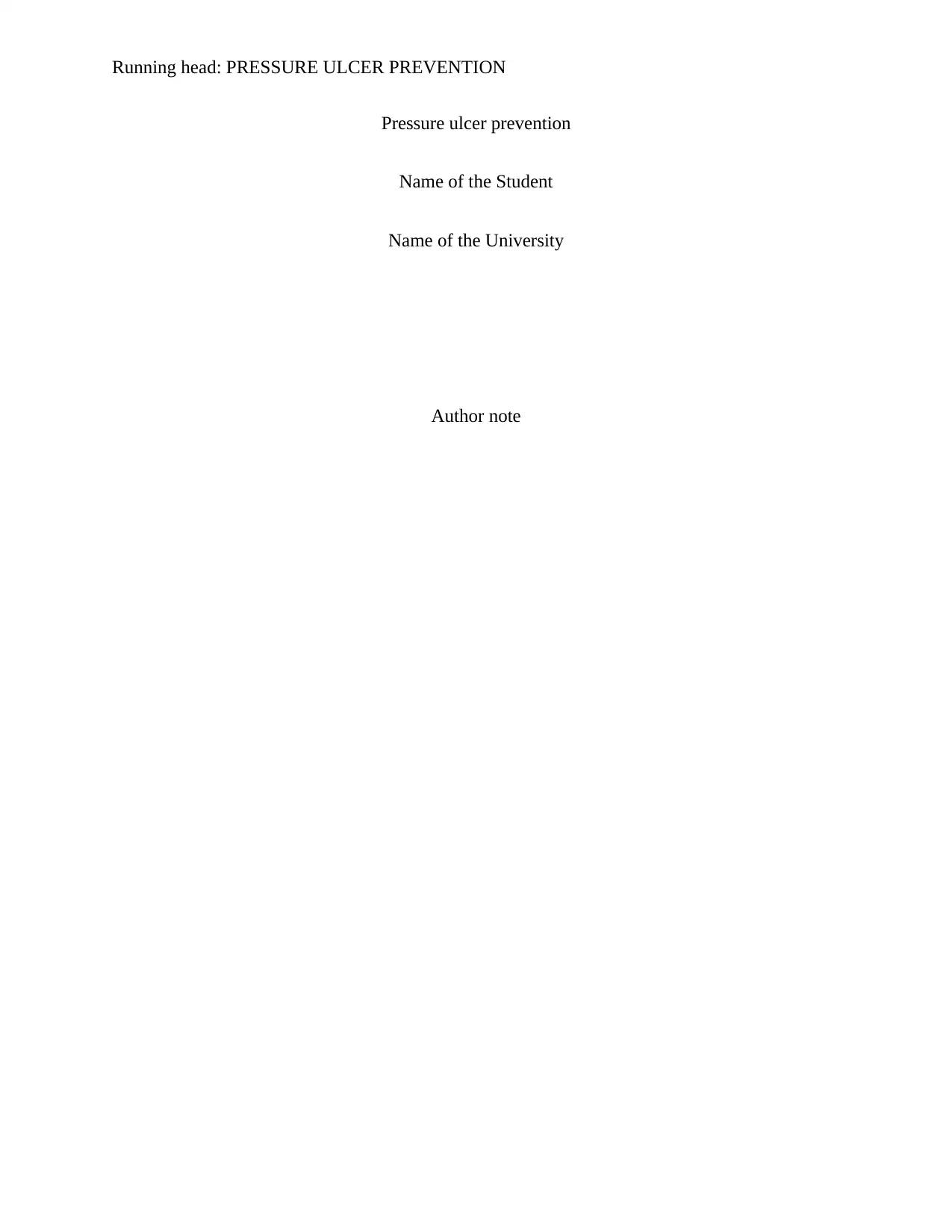
Running head: PRESSURE ULCER PREVENTION
Pressure ulcer prevention
Name of the Student
Name of the University
Author note
Pressure ulcer prevention
Name of the Student
Name of the University
Author note
Paraphrase This Document
Need a fresh take? Get an instant paraphrase of this document with our AI Paraphraser
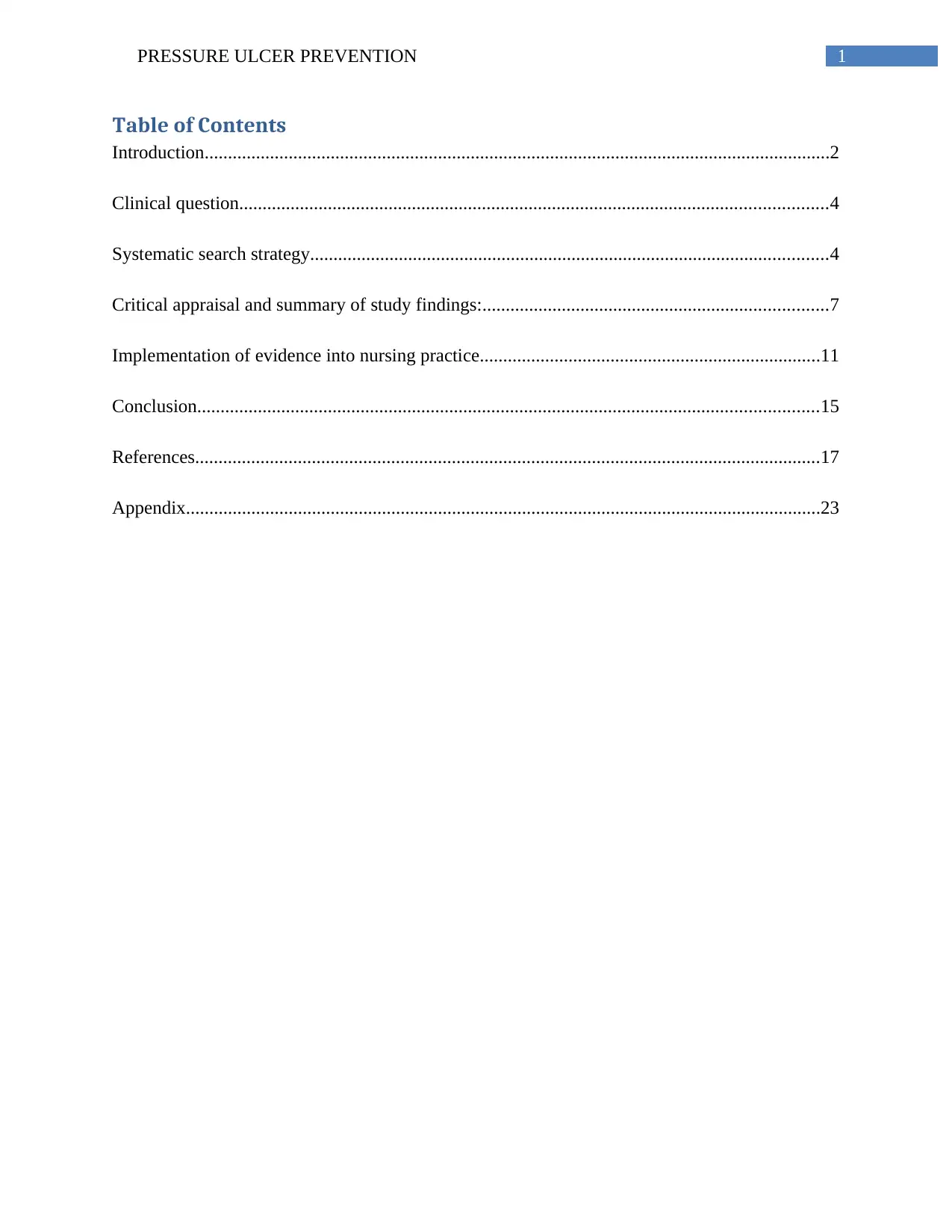
1PRESSURE ULCER PREVENTION
Table of Contents
Introduction......................................................................................................................................2
Clinical question..............................................................................................................................4
Systematic search strategy...............................................................................................................4
Critical appraisal and summary of study findings:..........................................................................7
Implementation of evidence into nursing practice.........................................................................11
Conclusion.....................................................................................................................................15
References......................................................................................................................................17
Appendix........................................................................................................................................23
Table of Contents
Introduction......................................................................................................................................2
Clinical question..............................................................................................................................4
Systematic search strategy...............................................................................................................4
Critical appraisal and summary of study findings:..........................................................................7
Implementation of evidence into nursing practice.........................................................................11
Conclusion.....................................................................................................................................15
References......................................................................................................................................17
Appendix........................................................................................................................................23
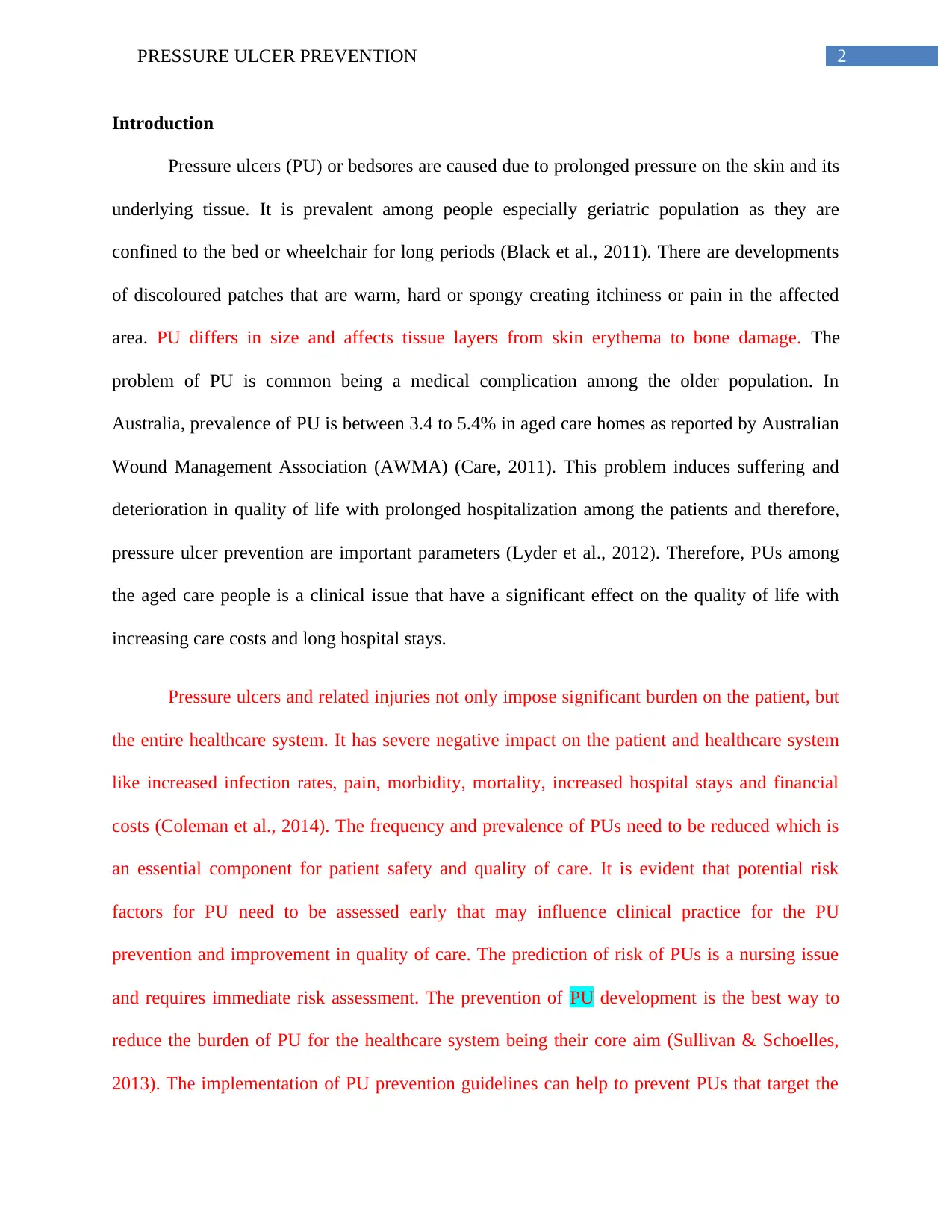
2PRESSURE ULCER PREVENTION
Introduction
Pressure ulcers (PU) or bedsores are caused due to prolonged pressure on the skin and its
underlying tissue. It is prevalent among people especially geriatric population as they are
confined to the bed or wheelchair for long periods (Black et al., 2011). There are developments
of discoloured patches that are warm, hard or spongy creating itchiness or pain in the affected
area. PU differs in size and affects tissue layers from skin erythema to bone damage. The
problem of PU is common being a medical complication among the older population. In
Australia, prevalence of PU is between 3.4 to 5.4% in aged care homes as reported by Australian
Wound Management Association (AWMA) (Care, 2011). This problem induces suffering and
deterioration in quality of life with prolonged hospitalization among the patients and therefore,
pressure ulcer prevention are important parameters (Lyder et al., 2012). Therefore, PUs among
the aged care people is a clinical issue that have a significant effect on the quality of life with
increasing care costs and long hospital stays.
Pressure ulcers and related injuries not only impose significant burden on the patient, but
the entire healthcare system. It has severe negative impact on the patient and healthcare system
like increased infection rates, pain, morbidity, mortality, increased hospital stays and financial
costs (Coleman et al., 2014). The frequency and prevalence of PUs need to be reduced which is
an essential component for patient safety and quality of care. It is evident that potential risk
factors for PU need to be assessed early that may influence clinical practice for the PU
prevention and improvement in quality of care. The prediction of risk of PUs is a nursing issue
and requires immediate risk assessment. The prevention of PU development is the best way to
reduce the burden of PU for the healthcare system being their core aim (Sullivan & Schoelles,
2013). The implementation of PU prevention guidelines can help to prevent PUs that target the
Introduction
Pressure ulcers (PU) or bedsores are caused due to prolonged pressure on the skin and its
underlying tissue. It is prevalent among people especially geriatric population as they are
confined to the bed or wheelchair for long periods (Black et al., 2011). There are developments
of discoloured patches that are warm, hard or spongy creating itchiness or pain in the affected
area. PU differs in size and affects tissue layers from skin erythema to bone damage. The
problem of PU is common being a medical complication among the older population. In
Australia, prevalence of PU is between 3.4 to 5.4% in aged care homes as reported by Australian
Wound Management Association (AWMA) (Care, 2011). This problem induces suffering and
deterioration in quality of life with prolonged hospitalization among the patients and therefore,
pressure ulcer prevention are important parameters (Lyder et al., 2012). Therefore, PUs among
the aged care people is a clinical issue that have a significant effect on the quality of life with
increasing care costs and long hospital stays.
Pressure ulcers and related injuries not only impose significant burden on the patient, but
the entire healthcare system. It has severe negative impact on the patient and healthcare system
like increased infection rates, pain, morbidity, mortality, increased hospital stays and financial
costs (Coleman et al., 2014). The frequency and prevalence of PUs need to be reduced which is
an essential component for patient safety and quality of care. It is evident that potential risk
factors for PU need to be assessed early that may influence clinical practice for the PU
prevention and improvement in quality of care. The prediction of risk of PUs is a nursing issue
and requires immediate risk assessment. The prevention of PU development is the best way to
reduce the burden of PU for the healthcare system being their core aim (Sullivan & Schoelles,
2013). The implementation of PU prevention guidelines can help to prevent PUs that target the
⊘ This is a preview!⊘
Do you want full access?
Subscribe today to unlock all pages.

Trusted by 1+ million students worldwide
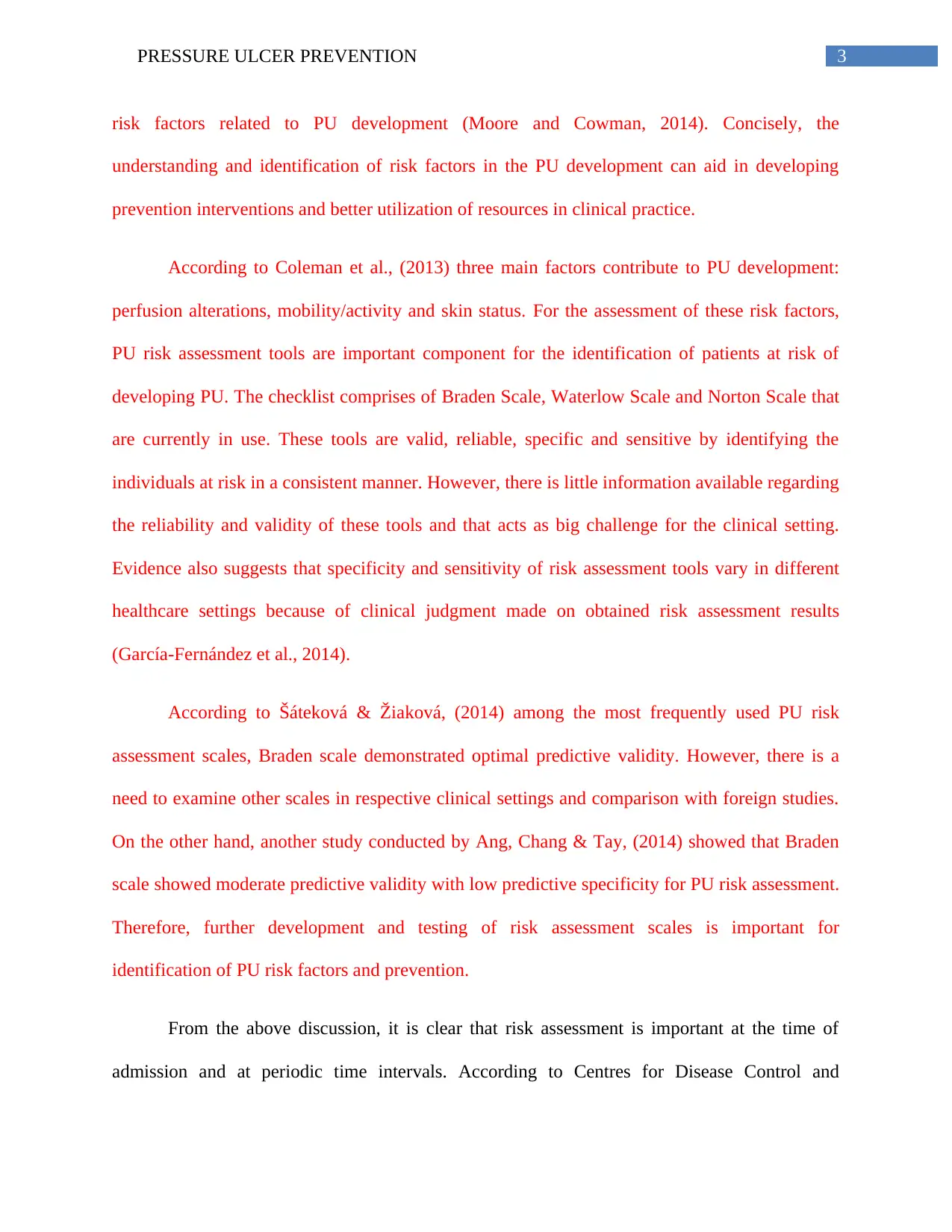
3PRESSURE ULCER PREVENTION
risk factors related to PU development (Moore and Cowman, 2014). Concisely, the
understanding and identification of risk factors in the PU development can aid in developing
prevention interventions and better utilization of resources in clinical practice.
According to Coleman et al., (2013) three main factors contribute to PU development:
perfusion alterations, mobility/activity and skin status. For the assessment of these risk factors,
PU risk assessment tools are important component for the identification of patients at risk of
developing PU. The checklist comprises of Braden Scale, Waterlow Scale and Norton Scale that
are currently in use. These tools are valid, reliable, specific and sensitive by identifying the
individuals at risk in a consistent manner. However, there is little information available regarding
the reliability and validity of these tools and that acts as big challenge for the clinical setting.
Evidence also suggests that specificity and sensitivity of risk assessment tools vary in different
healthcare settings because of clinical judgment made on obtained risk assessment results
(García-Fernández et al., 2014).
According to Šáteková & Žiaková, (2014) among the most frequently used PU risk
assessment scales, Braden scale demonstrated optimal predictive validity. However, there is a
need to examine other scales in respective clinical settings and comparison with foreign studies.
On the other hand, another study conducted by Ang, Chang & Tay, (2014) showed that Braden
scale showed moderate predictive validity with low predictive specificity for PU risk assessment.
Therefore, further development and testing of risk assessment scales is important for
identification of PU risk factors and prevention.
From the above discussion, it is clear that risk assessment is important at the time of
admission and at periodic time intervals. According to Centres for Disease Control and
risk factors related to PU development (Moore and Cowman, 2014). Concisely, the
understanding and identification of risk factors in the PU development can aid in developing
prevention interventions and better utilization of resources in clinical practice.
According to Coleman et al., (2013) three main factors contribute to PU development:
perfusion alterations, mobility/activity and skin status. For the assessment of these risk factors,
PU risk assessment tools are important component for the identification of patients at risk of
developing PU. The checklist comprises of Braden Scale, Waterlow Scale and Norton Scale that
are currently in use. These tools are valid, reliable, specific and sensitive by identifying the
individuals at risk in a consistent manner. However, there is little information available regarding
the reliability and validity of these tools and that acts as big challenge for the clinical setting.
Evidence also suggests that specificity and sensitivity of risk assessment tools vary in different
healthcare settings because of clinical judgment made on obtained risk assessment results
(García-Fernández et al., 2014).
According to Šáteková & Žiaková, (2014) among the most frequently used PU risk
assessment scales, Braden scale demonstrated optimal predictive validity. However, there is a
need to examine other scales in respective clinical settings and comparison with foreign studies.
On the other hand, another study conducted by Ang, Chang & Tay, (2014) showed that Braden
scale showed moderate predictive validity with low predictive specificity for PU risk assessment.
Therefore, further development and testing of risk assessment scales is important for
identification of PU risk factors and prevention.
From the above discussion, it is clear that risk assessment is important at the time of
admission and at periodic time intervals. According to Centres for Disease Control and
Paraphrase This Document
Need a fresh take? Get an instant paraphrase of this document with our AI Paraphraser
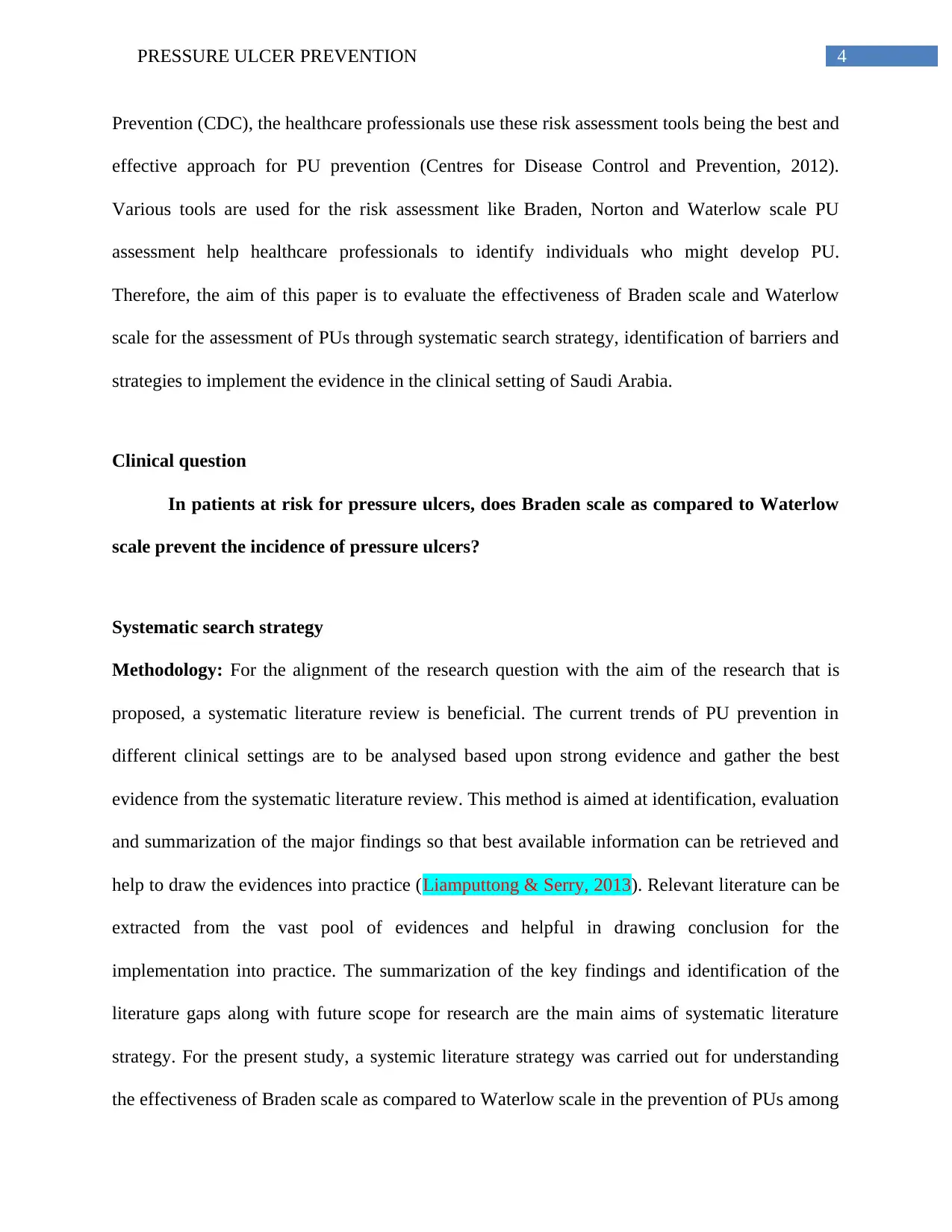
4PRESSURE ULCER PREVENTION
Prevention (CDC), the healthcare professionals use these risk assessment tools being the best and
effective approach for PU prevention (Centres for Disease Control and Prevention, 2012).
Various tools are used for the risk assessment like Braden, Norton and Waterlow scale PU
assessment help healthcare professionals to identify individuals who might develop PU.
Therefore, the aim of this paper is to evaluate the effectiveness of Braden scale and Waterlow
scale for the assessment of PUs through systematic search strategy, identification of barriers and
strategies to implement the evidence in the clinical setting of Saudi Arabia.
Clinical question
In patients at risk for pressure ulcers, does Braden scale as compared to Waterlow
scale prevent the incidence of pressure ulcers?
Systematic search strategy
Methodology: For the alignment of the research question with the aim of the research that is
proposed, a systematic literature review is beneficial. The current trends of PU prevention in
different clinical settings are to be analysed based upon strong evidence and gather the best
evidence from the systematic literature review. This method is aimed at identification, evaluation
and summarization of the major findings so that best available information can be retrieved and
help to draw the evidences into practice (Liamputtong & Serry, 2013). Relevant literature can be
extracted from the vast pool of evidences and helpful in drawing conclusion for the
implementation into practice. The summarization of the key findings and identification of the
literature gaps along with future scope for research are the main aims of systematic literature
strategy. For the present study, a systemic literature strategy was carried out for understanding
the effectiveness of Braden scale as compared to Waterlow scale in the prevention of PUs among
Prevention (CDC), the healthcare professionals use these risk assessment tools being the best and
effective approach for PU prevention (Centres for Disease Control and Prevention, 2012).
Various tools are used for the risk assessment like Braden, Norton and Waterlow scale PU
assessment help healthcare professionals to identify individuals who might develop PU.
Therefore, the aim of this paper is to evaluate the effectiveness of Braden scale and Waterlow
scale for the assessment of PUs through systematic search strategy, identification of barriers and
strategies to implement the evidence in the clinical setting of Saudi Arabia.
Clinical question
In patients at risk for pressure ulcers, does Braden scale as compared to Waterlow
scale prevent the incidence of pressure ulcers?
Systematic search strategy
Methodology: For the alignment of the research question with the aim of the research that is
proposed, a systematic literature review is beneficial. The current trends of PU prevention in
different clinical settings are to be analysed based upon strong evidence and gather the best
evidence from the systematic literature review. This method is aimed at identification, evaluation
and summarization of the major findings so that best available information can be retrieved and
help to draw the evidences into practice (Liamputtong & Serry, 2013). Relevant literature can be
extracted from the vast pool of evidences and helpful in drawing conclusion for the
implementation into practice. The summarization of the key findings and identification of the
literature gaps along with future scope for research are the main aims of systematic literature
strategy. For the present study, a systemic literature strategy was carried out for understanding
the effectiveness of Braden scale as compared to Waterlow scale in the prevention of PUs among
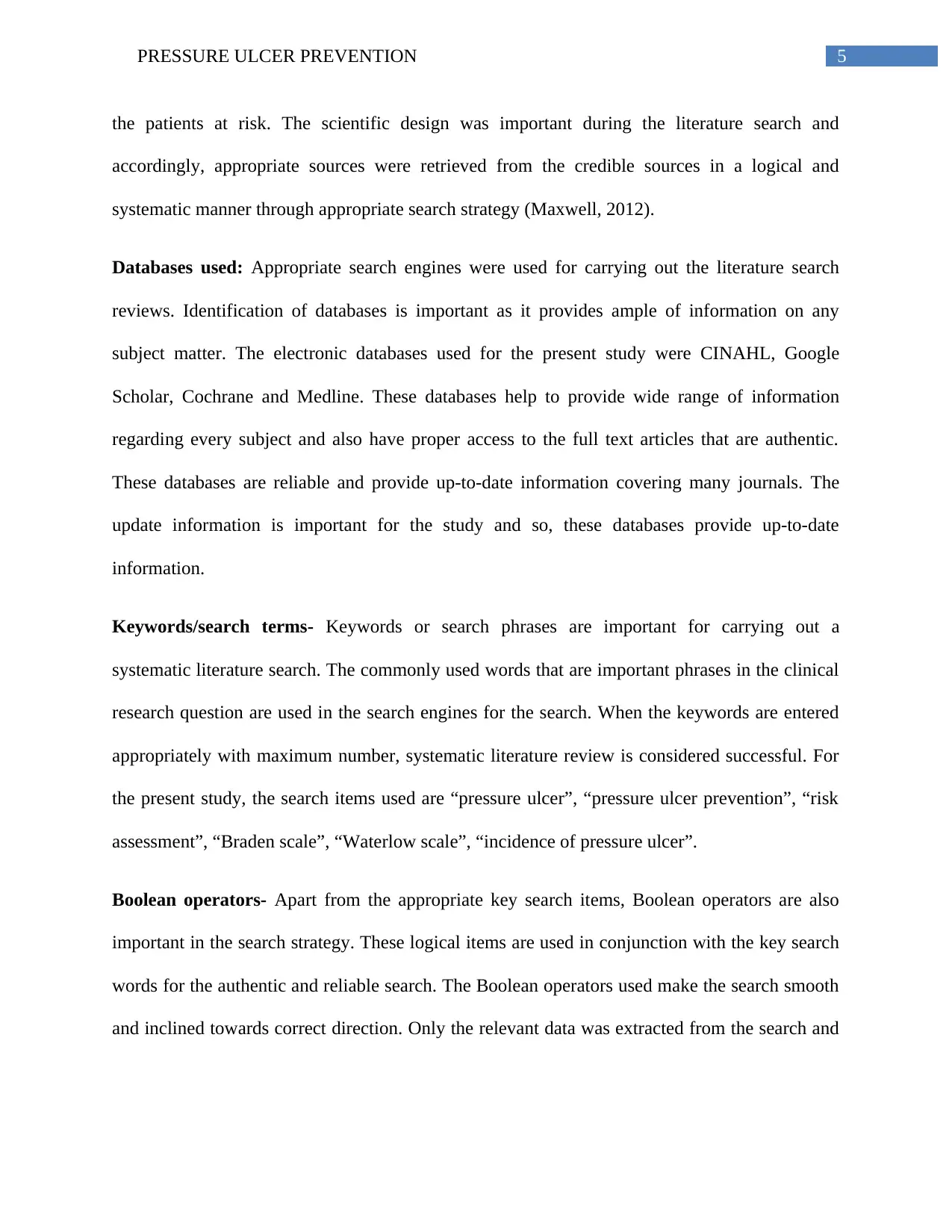
5PRESSURE ULCER PREVENTION
the patients at risk. The scientific design was important during the literature search and
accordingly, appropriate sources were retrieved from the credible sources in a logical and
systematic manner through appropriate search strategy (Maxwell, 2012).
Databases used: Appropriate search engines were used for carrying out the literature search
reviews. Identification of databases is important as it provides ample of information on any
subject matter. The electronic databases used for the present study were CINAHL, Google
Scholar, Cochrane and Medline. These databases help to provide wide range of information
regarding every subject and also have proper access to the full text articles that are authentic.
These databases are reliable and provide up-to-date information covering many journals. The
update information is important for the study and so, these databases provide up-to-date
information.
Keywords/search terms- Keywords or search phrases are important for carrying out a
systematic literature search. The commonly used words that are important phrases in the clinical
research question are used in the search engines for the search. When the keywords are entered
appropriately with maximum number, systematic literature review is considered successful. For
the present study, the search items used are “pressure ulcer”, “pressure ulcer prevention”, “risk
assessment”, “Braden scale”, “Waterlow scale”, “incidence of pressure ulcer”.
Boolean operators- Apart from the appropriate key search items, Boolean operators are also
important in the search strategy. These logical items are used in conjunction with the key search
words for the authentic and reliable search. The Boolean operators used make the search smooth
and inclined towards correct direction. Only the relevant data was extracted from the search and
the patients at risk. The scientific design was important during the literature search and
accordingly, appropriate sources were retrieved from the credible sources in a logical and
systematic manner through appropriate search strategy (Maxwell, 2012).
Databases used: Appropriate search engines were used for carrying out the literature search
reviews. Identification of databases is important as it provides ample of information on any
subject matter. The electronic databases used for the present study were CINAHL, Google
Scholar, Cochrane and Medline. These databases help to provide wide range of information
regarding every subject and also have proper access to the full text articles that are authentic.
These databases are reliable and provide up-to-date information covering many journals. The
update information is important for the study and so, these databases provide up-to-date
information.
Keywords/search terms- Keywords or search phrases are important for carrying out a
systematic literature search. The commonly used words that are important phrases in the clinical
research question are used in the search engines for the search. When the keywords are entered
appropriately with maximum number, systematic literature review is considered successful. For
the present study, the search items used are “pressure ulcer”, “pressure ulcer prevention”, “risk
assessment”, “Braden scale”, “Waterlow scale”, “incidence of pressure ulcer”.
Boolean operators- Apart from the appropriate key search items, Boolean operators are also
important in the search strategy. These logical items are used in conjunction with the key search
words for the authentic and reliable search. The Boolean operators used make the search smooth
and inclined towards correct direction. Only the relevant data was extracted from the search and
⊘ This is a preview!⊘
Do you want full access?
Subscribe today to unlock all pages.

Trusted by 1+ million students worldwide
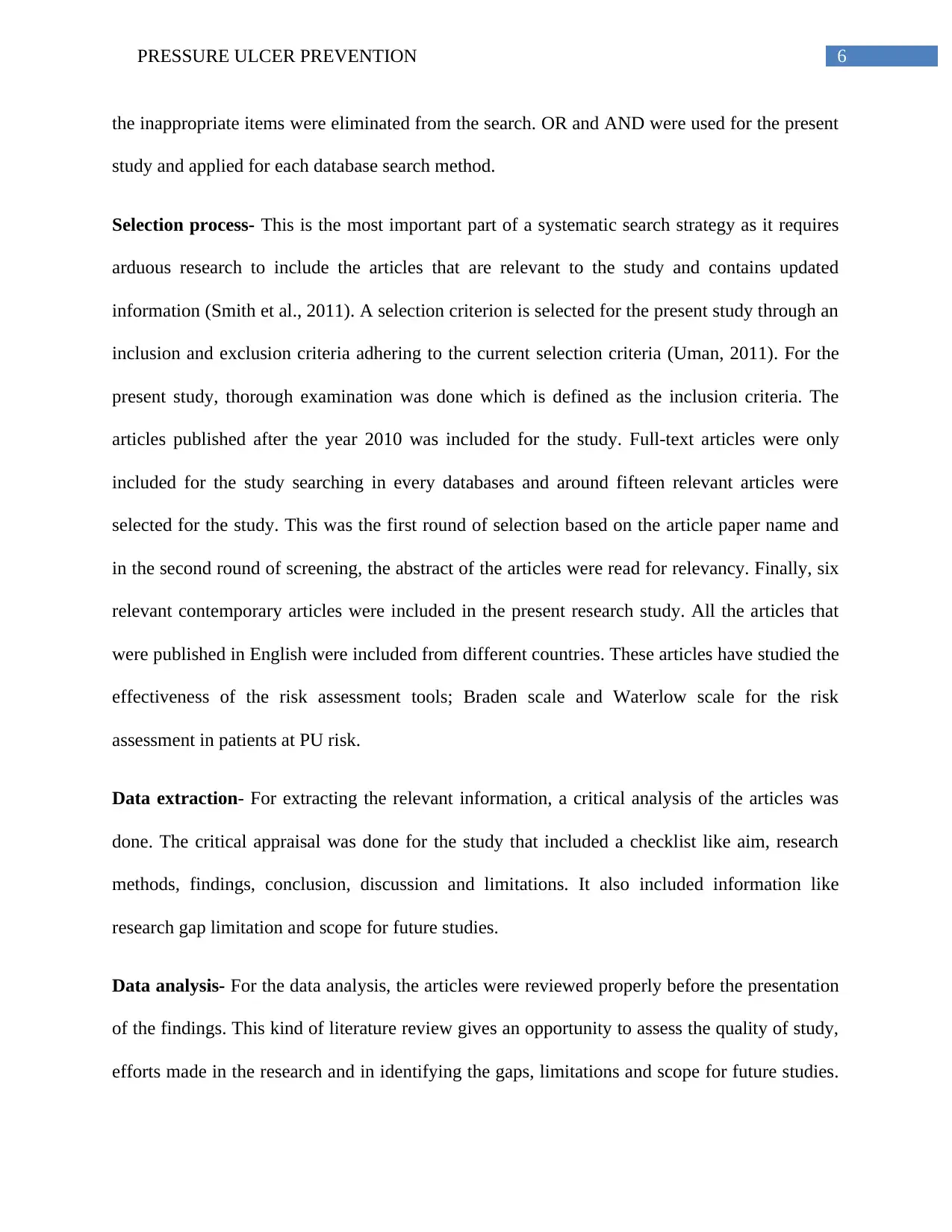
6PRESSURE ULCER PREVENTION
the inappropriate items were eliminated from the search. OR and AND were used for the present
study and applied for each database search method.
Selection process- This is the most important part of a systematic search strategy as it requires
arduous research to include the articles that are relevant to the study and contains updated
information (Smith et al., 2011). A selection criterion is selected for the present study through an
inclusion and exclusion criteria adhering to the current selection criteria (Uman, 2011). For the
present study, thorough examination was done which is defined as the inclusion criteria. The
articles published after the year 2010 was included for the study. Full-text articles were only
included for the study searching in every databases and around fifteen relevant articles were
selected for the study. This was the first round of selection based on the article paper name and
in the second round of screening, the abstract of the articles were read for relevancy. Finally, six
relevant contemporary articles were included in the present research study. All the articles that
were published in English were included from different countries. These articles have studied the
effectiveness of the risk assessment tools; Braden scale and Waterlow scale for the risk
assessment in patients at PU risk.
Data extraction- For extracting the relevant information, a critical analysis of the articles was
done. The critical appraisal was done for the study that included a checklist like aim, research
methods, findings, conclusion, discussion and limitations. It also included information like
research gap limitation and scope for future studies.
Data analysis- For the data analysis, the articles were reviewed properly before the presentation
of the findings. This kind of literature review gives an opportunity to assess the quality of study,
efforts made in the research and in identifying the gaps, limitations and scope for future studies.
the inappropriate items were eliminated from the search. OR and AND were used for the present
study and applied for each database search method.
Selection process- This is the most important part of a systematic search strategy as it requires
arduous research to include the articles that are relevant to the study and contains updated
information (Smith et al., 2011). A selection criterion is selected for the present study through an
inclusion and exclusion criteria adhering to the current selection criteria (Uman, 2011). For the
present study, thorough examination was done which is defined as the inclusion criteria. The
articles published after the year 2010 was included for the study. Full-text articles were only
included for the study searching in every databases and around fifteen relevant articles were
selected for the study. This was the first round of selection based on the article paper name and
in the second round of screening, the abstract of the articles were read for relevancy. Finally, six
relevant contemporary articles were included in the present research study. All the articles that
were published in English were included from different countries. These articles have studied the
effectiveness of the risk assessment tools; Braden scale and Waterlow scale for the risk
assessment in patients at PU risk.
Data extraction- For extracting the relevant information, a critical analysis of the articles was
done. The critical appraisal was done for the study that included a checklist like aim, research
methods, findings, conclusion, discussion and limitations. It also included information like
research gap limitation and scope for future studies.
Data analysis- For the data analysis, the articles were reviewed properly before the presentation
of the findings. This kind of literature review gives an opportunity to assess the quality of study,
efforts made in the research and in identifying the gaps, limitations and scope for future studies.
Paraphrase This Document
Need a fresh take? Get an instant paraphrase of this document with our AI Paraphraser
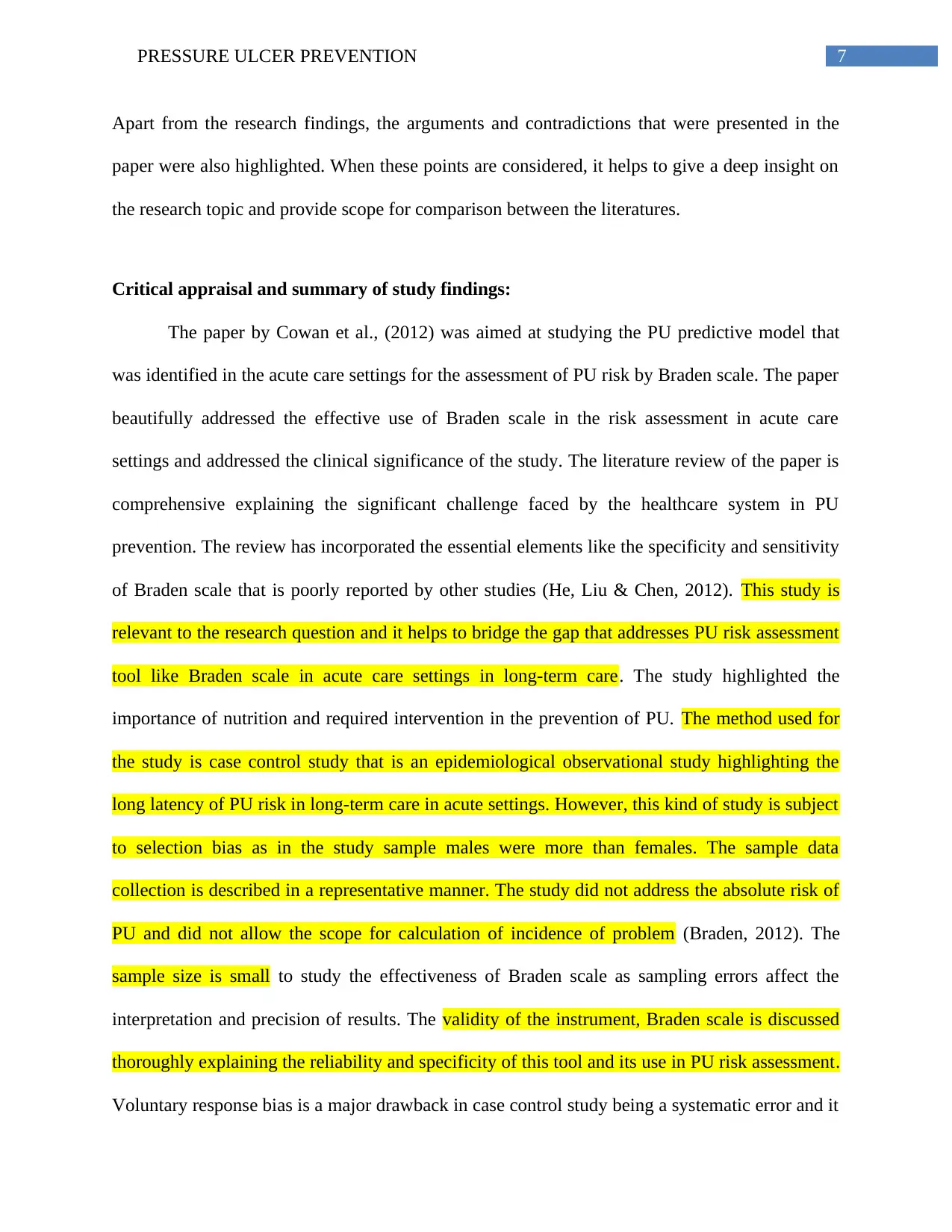
7PRESSURE ULCER PREVENTION
Apart from the research findings, the arguments and contradictions that were presented in the
paper were also highlighted. When these points are considered, it helps to give a deep insight on
the research topic and provide scope for comparison between the literatures.
Critical appraisal and summary of study findings:
The paper by Cowan et al., (2012) was aimed at studying the PU predictive model that
was identified in the acute care settings for the assessment of PU risk by Braden scale. The paper
beautifully addressed the effective use of Braden scale in the risk assessment in acute care
settings and addressed the clinical significance of the study. The literature review of the paper is
comprehensive explaining the significant challenge faced by the healthcare system in PU
prevention. The review has incorporated the essential elements like the specificity and sensitivity
of Braden scale that is poorly reported by other studies (He, Liu & Chen, 2012). This study is
relevant to the research question and it helps to bridge the gap that addresses PU risk assessment
tool like Braden scale in acute care settings in long-term care. The study highlighted the
importance of nutrition and required intervention in the prevention of PU. The method used for
the study is case control study that is an epidemiological observational study highlighting the
long latency of PU risk in long-term care in acute settings. However, this kind of study is subject
to selection bias as in the study sample males were more than females. The sample data
collection is described in a representative manner. The study did not address the absolute risk of
PU and did not allow the scope for calculation of incidence of problem (Braden, 2012). The
sample size is small to study the effectiveness of Braden scale as sampling errors affect the
interpretation and precision of results. The validity of the instrument, Braden scale is discussed
thoroughly explaining the reliability and specificity of this tool and its use in PU risk assessment.
Voluntary response bias is a major drawback in case control study being a systematic error and it
Apart from the research findings, the arguments and contradictions that were presented in the
paper were also highlighted. When these points are considered, it helps to give a deep insight on
the research topic and provide scope for comparison between the literatures.
Critical appraisal and summary of study findings:
The paper by Cowan et al., (2012) was aimed at studying the PU predictive model that
was identified in the acute care settings for the assessment of PU risk by Braden scale. The paper
beautifully addressed the effective use of Braden scale in the risk assessment in acute care
settings and addressed the clinical significance of the study. The literature review of the paper is
comprehensive explaining the significant challenge faced by the healthcare system in PU
prevention. The review has incorporated the essential elements like the specificity and sensitivity
of Braden scale that is poorly reported by other studies (He, Liu & Chen, 2012). This study is
relevant to the research question and it helps to bridge the gap that addresses PU risk assessment
tool like Braden scale in acute care settings in long-term care. The study highlighted the
importance of nutrition and required intervention in the prevention of PU. The method used for
the study is case control study that is an epidemiological observational study highlighting the
long latency of PU risk in long-term care in acute settings. However, this kind of study is subject
to selection bias as in the study sample males were more than females. The sample data
collection is described in a representative manner. The study did not address the absolute risk of
PU and did not allow the scope for calculation of incidence of problem (Braden, 2012). The
sample size is small to study the effectiveness of Braden scale as sampling errors affect the
interpretation and precision of results. The validity of the instrument, Braden scale is discussed
thoroughly explaining the reliability and specificity of this tool and its use in PU risk assessment.
Voluntary response bias is a major drawback in case control study being a systematic error and it
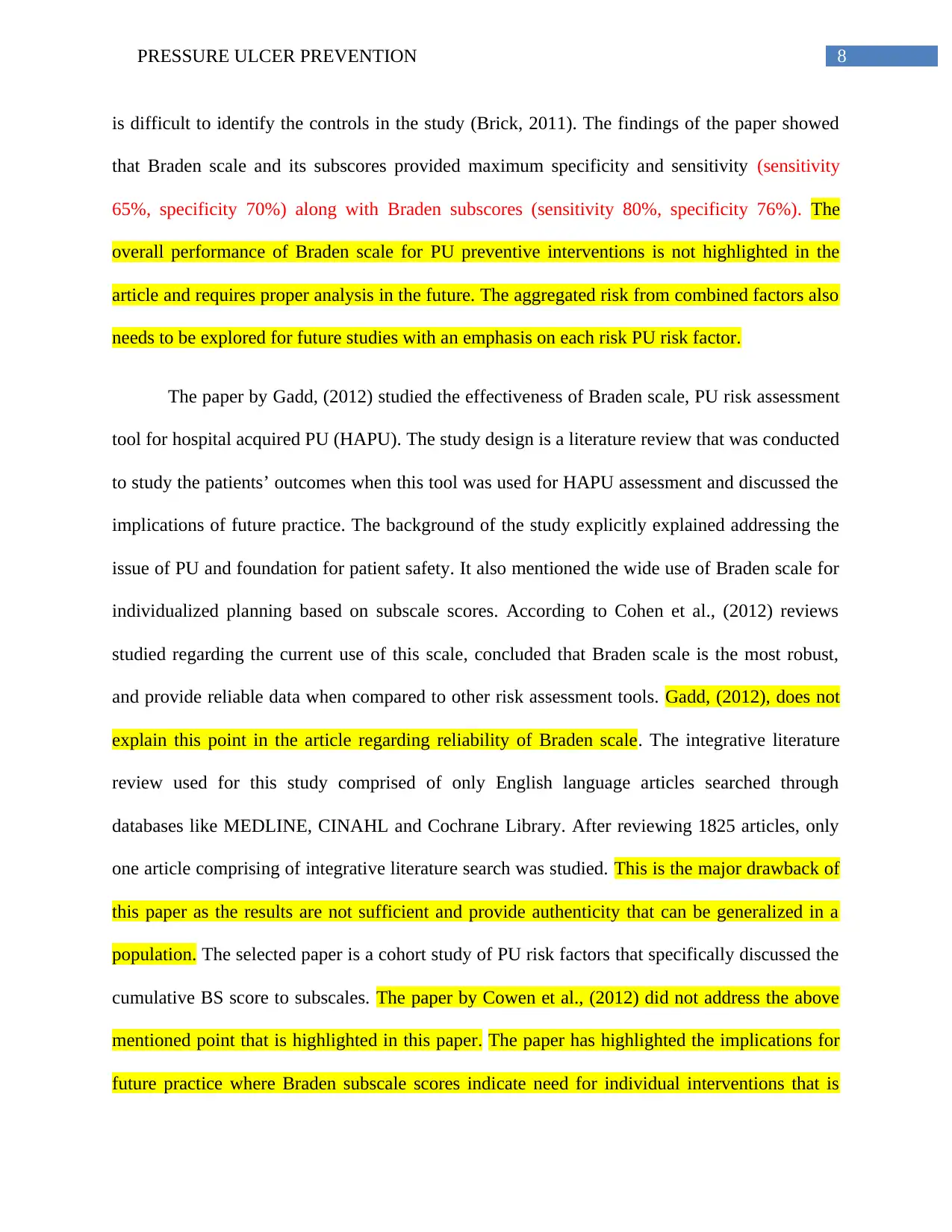
8PRESSURE ULCER PREVENTION
is difficult to identify the controls in the study (Brick, 2011). The findings of the paper showed
that Braden scale and its subscores provided maximum specificity and sensitivity (sensitivity
65%, specificity 70%) along with Braden subscores (sensitivity 80%, specificity 76%). The
overall performance of Braden scale for PU preventive interventions is not highlighted in the
article and requires proper analysis in the future. The aggregated risk from combined factors also
needs to be explored for future studies with an emphasis on each risk PU risk factor.
The paper by Gadd, (2012) studied the effectiveness of Braden scale, PU risk assessment
tool for hospital acquired PU (HAPU). The study design is a literature review that was conducted
to study the patients’ outcomes when this tool was used for HAPU assessment and discussed the
implications of future practice. The background of the study explicitly explained addressing the
issue of PU and foundation for patient safety. It also mentioned the wide use of Braden scale for
individualized planning based on subscale scores. According to Cohen et al., (2012) reviews
studied regarding the current use of this scale, concluded that Braden scale is the most robust,
and provide reliable data when compared to other risk assessment tools. Gadd, (2012), does not
explain this point in the article regarding reliability of Braden scale. The integrative literature
review used for this study comprised of only English language articles searched through
databases like MEDLINE, CINAHL and Cochrane Library. After reviewing 1825 articles, only
one article comprising of integrative literature search was studied. This is the major drawback of
this paper as the results are not sufficient and provide authenticity that can be generalized in a
population. The selected paper is a cohort study of PU risk factors that specifically discussed the
cumulative BS score to subscales. The paper by Cowen et al., (2012) did not address the above
mentioned point that is highlighted in this paper. The paper has highlighted the implications for
future practice where Braden subscale scores indicate need for individual interventions that is
is difficult to identify the controls in the study (Brick, 2011). The findings of the paper showed
that Braden scale and its subscores provided maximum specificity and sensitivity (sensitivity
65%, specificity 70%) along with Braden subscores (sensitivity 80%, specificity 76%). The
overall performance of Braden scale for PU preventive interventions is not highlighted in the
article and requires proper analysis in the future. The aggregated risk from combined factors also
needs to be explored for future studies with an emphasis on each risk PU risk factor.
The paper by Gadd, (2012) studied the effectiveness of Braden scale, PU risk assessment
tool for hospital acquired PU (HAPU). The study design is a literature review that was conducted
to study the patients’ outcomes when this tool was used for HAPU assessment and discussed the
implications of future practice. The background of the study explicitly explained addressing the
issue of PU and foundation for patient safety. It also mentioned the wide use of Braden scale for
individualized planning based on subscale scores. According to Cohen et al., (2012) reviews
studied regarding the current use of this scale, concluded that Braden scale is the most robust,
and provide reliable data when compared to other risk assessment tools. Gadd, (2012), does not
explain this point in the article regarding reliability of Braden scale. The integrative literature
review used for this study comprised of only English language articles searched through
databases like MEDLINE, CINAHL and Cochrane Library. After reviewing 1825 articles, only
one article comprising of integrative literature search was studied. This is the major drawback of
this paper as the results are not sufficient and provide authenticity that can be generalized in a
population. The selected paper is a cohort study of PU risk factors that specifically discussed the
cumulative BS score to subscales. The paper by Cowen et al., (2012) did not address the above
mentioned point that is highlighted in this paper. The paper has highlighted the implications for
future practice where Braden subscale scores indicate need for individual interventions that is
⊘ This is a preview!⊘
Do you want full access?
Subscribe today to unlock all pages.

Trusted by 1+ million students worldwide

9PRESSURE ULCER PREVENTION
generally overlooked in patient-centred care. This paper mentioned that Braden scale is a reliable
tool, however, further evaluation of individual Braden subscores based on clinical judgment is
required that affect risk assessment and PU prevention.
The paper by Iranmanesh, Rafiei & Sabzevari, (2012) was a prospective descriptive study
where the purpose was to determine the relationship between Braden scale and PU development.
The study was significant as it studied that score obtained in Braden scale is inversely
proportional to PU risk. The main finding of the paper is that it is a useful tool for the prediction
of PU in trauma ICU patients. The paper also suggested other factors like age and consciousness
level that also influences the PU development. The study highlighted that PU risk is high in Iran
and nurses do not use any scale for the prediction of PU development and risk assessment.
Concisely, the study conducted is good and results indicated that Braden scale is a good predictor
for PU development among critically ill trauma patients in Iran. Based on the results obtained in
the study, the most significant difference between patients with or without PU was found in
sensory perception where they were able to responds meaningfully to pressure-related
discomfort. Other scales Waterlow, Norton and Cubbin-Jackson scale were used in patients for
high PU development risk for quality improvement in trauma ICUs (Chou et al., 2013). Mean
Braden score was 13·4 ± 3·5 as compared to Glasgow coma scale was 10·6 ± 3·7.
The paper by Tayyib, Coyer & Lewis, (2016) conducted a prospective cohort study
design for identification and PU risk incidence in ICU settings in Saudi Arabia. Out of 84
participants, over 33 participants were identified with new PUs of 39.3% (U=537⋅5, z=1098⋅5,
P=0.004). Lower Braden scale scores predicted the PU development higher as compared to other
studies (Gadd, 2014). The data collection method is not proper as it is limited by time. The study
generally overlooked in patient-centred care. This paper mentioned that Braden scale is a reliable
tool, however, further evaluation of individual Braden subscores based on clinical judgment is
required that affect risk assessment and PU prevention.
The paper by Iranmanesh, Rafiei & Sabzevari, (2012) was a prospective descriptive study
where the purpose was to determine the relationship between Braden scale and PU development.
The study was significant as it studied that score obtained in Braden scale is inversely
proportional to PU risk. The main finding of the paper is that it is a useful tool for the prediction
of PU in trauma ICU patients. The paper also suggested other factors like age and consciousness
level that also influences the PU development. The study highlighted that PU risk is high in Iran
and nurses do not use any scale for the prediction of PU development and risk assessment.
Concisely, the study conducted is good and results indicated that Braden scale is a good predictor
for PU development among critically ill trauma patients in Iran. Based on the results obtained in
the study, the most significant difference between patients with or without PU was found in
sensory perception where they were able to responds meaningfully to pressure-related
discomfort. Other scales Waterlow, Norton and Cubbin-Jackson scale were used in patients for
high PU development risk for quality improvement in trauma ICUs (Chou et al., 2013). Mean
Braden score was 13·4 ± 3·5 as compared to Glasgow coma scale was 10·6 ± 3·7.
The paper by Tayyib, Coyer & Lewis, (2016) conducted a prospective cohort study
design for identification and PU risk incidence in ICU settings in Saudi Arabia. Out of 84
participants, over 33 participants were identified with new PUs of 39.3% (U=537⋅5, z=1098⋅5,
P=0.004). Lower Braden scale scores predicted the PU development higher as compared to other
studies (Gadd, 2014). The data collection method is not proper as it is limited by time. The study
Paraphrase This Document
Need a fresh take? Get an instant paraphrase of this document with our AI Paraphraser
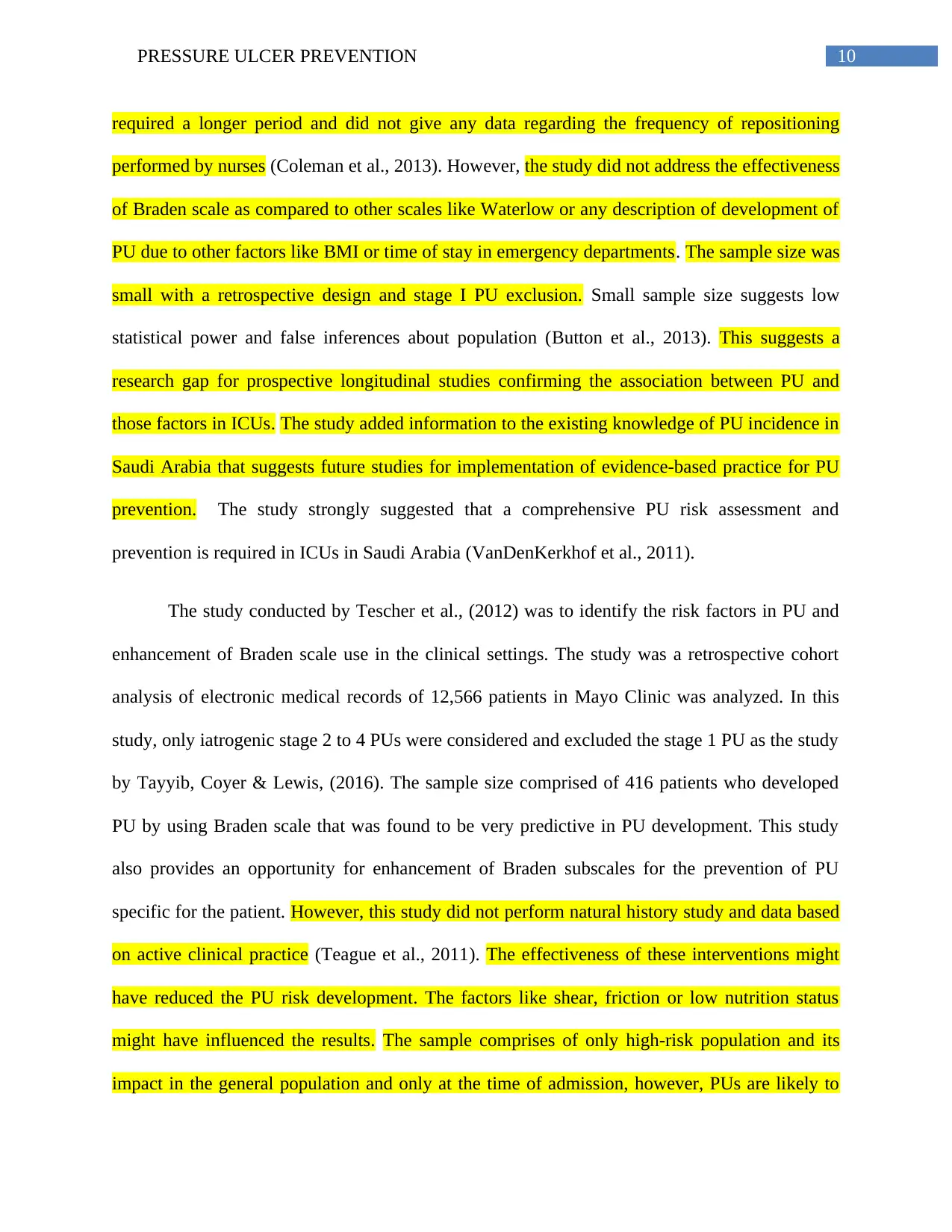
10PRESSURE ULCER PREVENTION
required a longer period and did not give any data regarding the frequency of repositioning
performed by nurses (Coleman et al., 2013). However, the study did not address the effectiveness
of Braden scale as compared to other scales like Waterlow or any description of development of
PU due to other factors like BMI or time of stay in emergency departments. The sample size was
small with a retrospective design and stage I PU exclusion. Small sample size suggests low
statistical power and false inferences about population (Button et al., 2013). This suggests a
research gap for prospective longitudinal studies confirming the association between PU and
those factors in ICUs. The study added information to the existing knowledge of PU incidence in
Saudi Arabia that suggests future studies for implementation of evidence-based practice for PU
prevention. The study strongly suggested that a comprehensive PU risk assessment and
prevention is required in ICUs in Saudi Arabia (VanDenKerkhof et al., 2011).
The study conducted by Tescher et al., (2012) was to identify the risk factors in PU and
enhancement of Braden scale use in the clinical settings. The study was a retrospective cohort
analysis of electronic medical records of 12,566 patients in Mayo Clinic was analyzed. In this
study, only iatrogenic stage 2 to 4 PUs were considered and excluded the stage 1 PU as the study
by Tayyib, Coyer & Lewis, (2016). The sample size comprised of 416 patients who developed
PU by using Braden scale that was found to be very predictive in PU development. This study
also provides an opportunity for enhancement of Braden subscales for the prevention of PU
specific for the patient. However, this study did not perform natural history study and data based
on active clinical practice (Teague et al., 2011). The effectiveness of these interventions might
have reduced the PU risk development. The factors like shear, friction or low nutrition status
might have influenced the results. The sample comprises of only high-risk population and its
impact in the general population and only at the time of admission, however, PUs are likely to
required a longer period and did not give any data regarding the frequency of repositioning
performed by nurses (Coleman et al., 2013). However, the study did not address the effectiveness
of Braden scale as compared to other scales like Waterlow or any description of development of
PU due to other factors like BMI or time of stay in emergency departments. The sample size was
small with a retrospective design and stage I PU exclusion. Small sample size suggests low
statistical power and false inferences about population (Button et al., 2013). This suggests a
research gap for prospective longitudinal studies confirming the association between PU and
those factors in ICUs. The study added information to the existing knowledge of PU incidence in
Saudi Arabia that suggests future studies for implementation of evidence-based practice for PU
prevention. The study strongly suggested that a comprehensive PU risk assessment and
prevention is required in ICUs in Saudi Arabia (VanDenKerkhof et al., 2011).
The study conducted by Tescher et al., (2012) was to identify the risk factors in PU and
enhancement of Braden scale use in the clinical settings. The study was a retrospective cohort
analysis of electronic medical records of 12,566 patients in Mayo Clinic was analyzed. In this
study, only iatrogenic stage 2 to 4 PUs were considered and excluded the stage 1 PU as the study
by Tayyib, Coyer & Lewis, (2016). The sample size comprised of 416 patients who developed
PU by using Braden scale that was found to be very predictive in PU development. This study
also provides an opportunity for enhancement of Braden subscales for the prevention of PU
specific for the patient. However, this study did not perform natural history study and data based
on active clinical practice (Teague et al., 2011). The effectiveness of these interventions might
have reduced the PU risk development. The factors like shear, friction or low nutrition status
might have influenced the results. The sample comprises of only high-risk population and its
impact in the general population and only at the time of admission, however, PUs are likely to
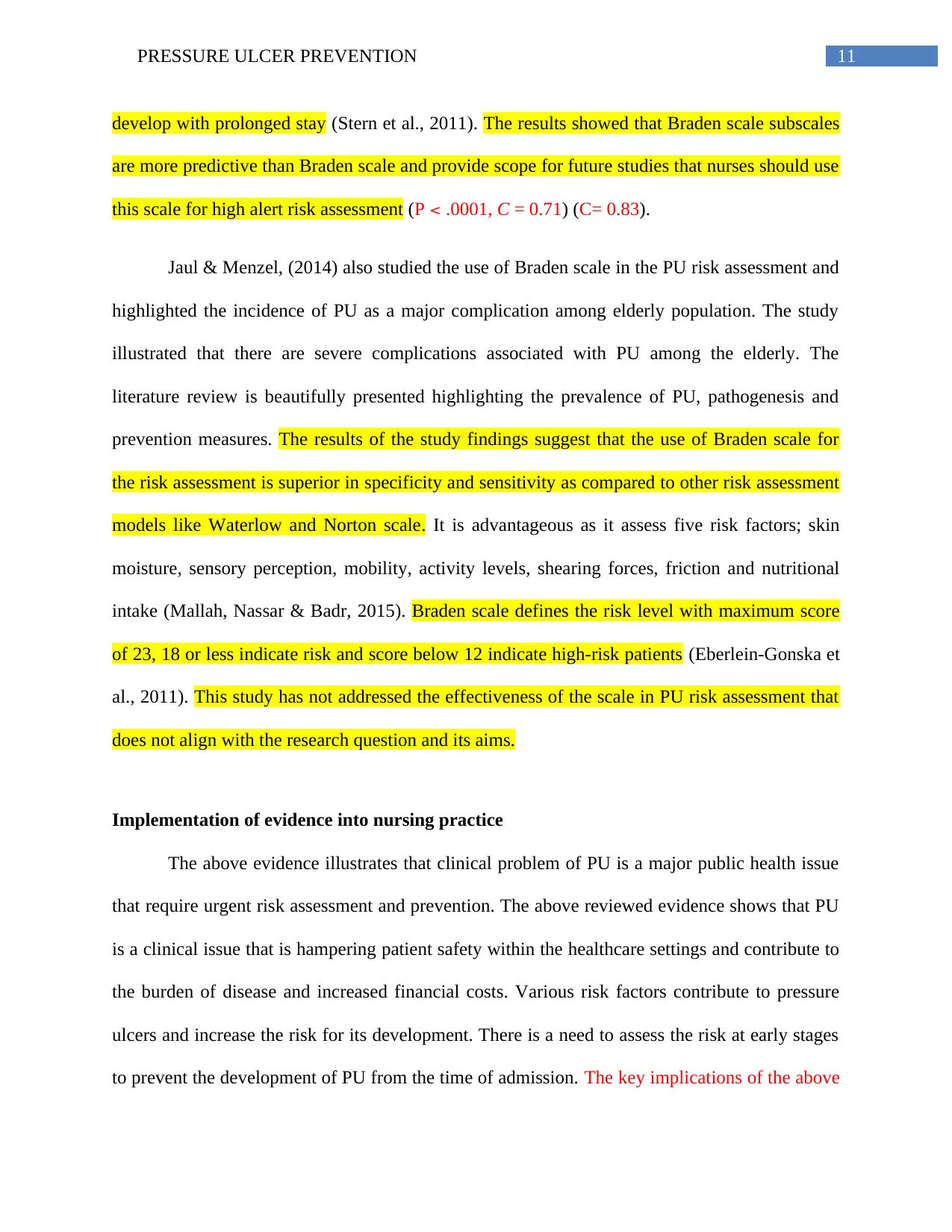
11PRESSURE ULCER PREVENTION
develop with prolonged stay (Stern et al., 2011). The results showed that Braden scale subscales
are more predictive than Braden scale and provide scope for future studies that nurses should use
this scale for high alert risk assessment (P < .0001, C = 0.71) (C= 0.83).
Jaul & Menzel, (2014) also studied the use of Braden scale in the PU risk assessment and
highlighted the incidence of PU as a major complication among elderly population. The study
illustrated that there are severe complications associated with PU among the elderly. The
literature review is beautifully presented highlighting the prevalence of PU, pathogenesis and
prevention measures. The results of the study findings suggest that the use of Braden scale for
the risk assessment is superior in specificity and sensitivity as compared to other risk assessment
models like Waterlow and Norton scale. It is advantageous as it assess five risk factors; skin
moisture, sensory perception, mobility, activity levels, shearing forces, friction and nutritional
intake (Mallah, Nassar & Badr, 2015). Braden scale defines the risk level with maximum score
of 23, 18 or less indicate risk and score below 12 indicate high-risk patients (Eberlein-Gonska et
al., 2011). This study has not addressed the effectiveness of the scale in PU risk assessment that
does not align with the research question and its aims.
Implementation of evidence into nursing practice
The above evidence illustrates that clinical problem of PU is a major public health issue
that require urgent risk assessment and prevention. The above reviewed evidence shows that PU
is a clinical issue that is hampering patient safety within the healthcare settings and contribute to
the burden of disease and increased financial costs. Various risk factors contribute to pressure
ulcers and increase the risk for its development. There is a need to assess the risk at early stages
to prevent the development of PU from the time of admission. The key implications of the above
develop with prolonged stay (Stern et al., 2011). The results showed that Braden scale subscales
are more predictive than Braden scale and provide scope for future studies that nurses should use
this scale for high alert risk assessment (P < .0001, C = 0.71) (C= 0.83).
Jaul & Menzel, (2014) also studied the use of Braden scale in the PU risk assessment and
highlighted the incidence of PU as a major complication among elderly population. The study
illustrated that there are severe complications associated with PU among the elderly. The
literature review is beautifully presented highlighting the prevalence of PU, pathogenesis and
prevention measures. The results of the study findings suggest that the use of Braden scale for
the risk assessment is superior in specificity and sensitivity as compared to other risk assessment
models like Waterlow and Norton scale. It is advantageous as it assess five risk factors; skin
moisture, sensory perception, mobility, activity levels, shearing forces, friction and nutritional
intake (Mallah, Nassar & Badr, 2015). Braden scale defines the risk level with maximum score
of 23, 18 or less indicate risk and score below 12 indicate high-risk patients (Eberlein-Gonska et
al., 2011). This study has not addressed the effectiveness of the scale in PU risk assessment that
does not align with the research question and its aims.
Implementation of evidence into nursing practice
The above evidence illustrates that clinical problem of PU is a major public health issue
that require urgent risk assessment and prevention. The above reviewed evidence shows that PU
is a clinical issue that is hampering patient safety within the healthcare settings and contribute to
the burden of disease and increased financial costs. Various risk factors contribute to pressure
ulcers and increase the risk for its development. There is a need to assess the risk at early stages
to prevent the development of PU from the time of admission. The key implications of the above
⊘ This is a preview!⊘
Do you want full access?
Subscribe today to unlock all pages.

Trusted by 1+ million students worldwide
1 out of 29
Related Documents
Your All-in-One AI-Powered Toolkit for Academic Success.
+13062052269
info@desklib.com
Available 24*7 on WhatsApp / Email
![[object Object]](/_next/static/media/star-bottom.7253800d.svg)
Unlock your academic potential
Copyright © 2020–2025 A2Z Services. All Rights Reserved. Developed and managed by ZUCOL.




